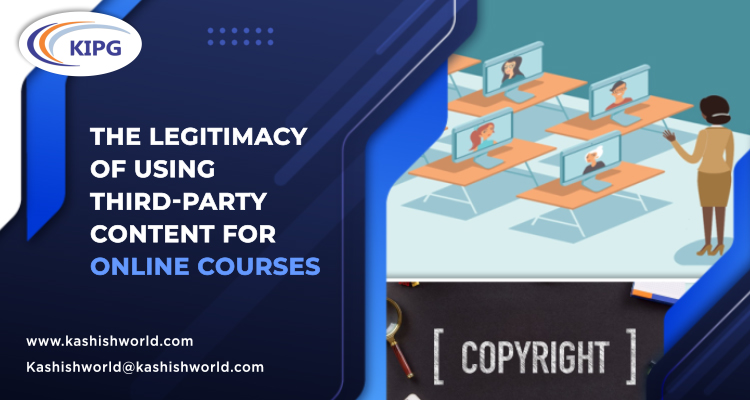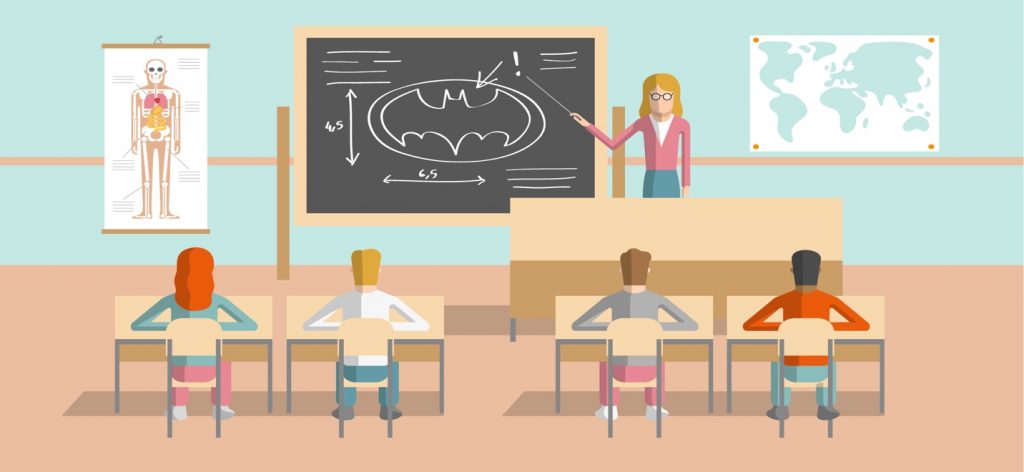
There has been sprouting of different avenues to make education at all levels possible and accessible for people from all walks of life. Since the past decade and the evolving use of the internet, distance learning has become a much viable option for many with limited access to resources as well as for those who wish to engage in a learning experience. Distributed education has meant more diverse learning; however, it has generated a few copyright concerns that might be viewed as roadblocks for virtual educational systems, which is why it is imperative to make a rudimentary inquiry into the same.
Unwinding Copyright vis-à-vis Virtual Education
Copyright provides an extensive spectrum of exclusive rights to authors of original works. While there are a majority of rights in favor of the author, this right is not an absolute right. There are certain exemptions to utilizing these works, which allows third parties to utilize the content of the copyrighted material without seeking prior permission from the owner. These are generally referred to as the fair dealing or fair use provisions.
Fair Use Exception: The ‘Fair Use Exception’ has been incorporated to balance the scale of privatization and public utilization. It allows the reproduction or the use of a copyrighted work in a manner not amounting to infringement of copyright by not hampering the monopolistic rights of the author. It emanates from the ‘Doctrine of Equity.’ It is also reflected in the Agreement on Trade-Related Aspects of Intellectual Property Rights (TRIPS) in Article 13, which states that:
“Members shall confine limitations or exceptions to exclusive rights to certain special cases which do not conflict with a normal exploitation of the work and do not unreasonably prejudice the legitimate interests of the rights holder.”
By such virtue of allowing certain special cases, all Member States to the World Trade Organization (WTO) are bound to comply and reflect the like provision in their respective domestic legislation. It complies with the Berne Convention for the Protection of Literary and Artistic Works and the TRIPS Agreement.
Fair-use has been attempted to be defined as per the words of Lord Denning in Hubbard vs. Vosper, wherein it was observed that:
“It is impossible to define what is ‘fair dealing.’ It must be a question of degree. You must consider first the number and extent of the quotations and extracts. Are they altogether too many and too long to be fair? Then you must consider the use made of them. If they are used as a basis for comment, criticism, or review, then that may be fair dealing. If they are used to convey the same information as the author for a rival purpose, that may be unfair. Next, you must consider the proportions. To take long extracts and attach short comments may be unfair. But, short extracts and long comments may be fair. Other considerations may come to mind also. But after all is said and done, it must be a matter of impression.”
As per the doctrine of fair use, the law generally exempts the use of copyrighted works in face-to-face teaching, where a non-profit educational use is concerned. The same may not apply to online teaching and material sharing as it becomes comparatively difficult to exercise control and surveillance.
The fair use exemption may be found in many Copyright Laws like in India, the United Kingdom, the United States, Australia, etc., as a provision to facilitate copyrighted works being used by educational institutions without compromising the holder’s rights. However, in certain countries like France, Germany, Spain, Netherlands, Sweden, and Switzerland, the doctrine of fair use is not recognized.
Section 52 of the Indian Copyright Act, 1957 restricts the fair use of copyrighted works as it specifies that such use shall be made for the purpose of studies in an educational institution. This provision, however, has been broadly interpreted in The Chancellor, Masters & amp; Scholars of the University of Oxford & Ors. vs. Rameshwari Photocopy Services & Ors. to extend beyond the traditional boundary walls of a classroom to realize the true meaning of the provision. The provision also restricts the non-teaching staff by including only teachers and students.
In the United States, the Copyright Act embraces a wider outlook of considering whether a work results in fair use or not by providing guidelines for subjective analysis. While adjudging that some particular criticism, comment, news reporting, teaching (including multiple copies for classroom use), scholarship, or research forms a fair use or not, the following factors should be considered:
- The purpose and character of the use, including the interpretation of whether such use is of a commercial nature or is for non-profit educational purposes;
- The nature of the copyright-protected work;
- The amount and substantiality of the portion used concerning the copyrighted work as a whole; and
- The effect of the use upon the potential market or value of the copyrighted work.
The Canadian Copyright Act, 1985 is also narrowly construed since it explicitly permits educational institutions as well as a “person acting under its authority for the purposes of education or training on its premises to reproduce a work, or do any other necessary act, in order to display it.” The fact that it needs to be within the premise of the institution makes it a restricted exemption. However, it does allow online education to certain limits, considering the given limitation.
The Chinese Copyright Act and Regulations on Protection of the Right of Communication via Information Network has appropriately introduced distance learning as being an inclusive component of fair dealing. Article 8 allows the reproduction of courses to registered students through information networks by distance education institutions. However, it requires that some remuneration be paid to the copyright author.
Classroom Exemption: In the United States, Section 110(1) of the Copyright Act is commonly known as the classroom exemption, which allows the performance and display of any copyrighted work by students or teachers given that the following conditions are met:
- Such use takes place in a non-profit educational institution;
- It is used for face-to-face reference, i.e., the teachers and the students are present in the same place;
- It occurs preferably in a classroom or a similar place devoted to instruction (for example, a laboratory or library); and
- If the copyrighted work is an audio-visual work, then the copy that is performed is lawfully made.

Section 110(2) embraces a restrictive approach when compared to Section 110(1) as it deals with performances and displays in the course of transmission. Institutions transmitting the course can only utilize on-dramatic literary or musical works if the permission of the rights holder is sought after paying the requested royalty fee. Therefore, it is barely an exception as the following have to be ensured to be compliant with Section 110(2):
- The work must be part of the systematic instructional activities of either a non-profit educational institution or governmental body;
- It is directly related and of material assistance to the teaching content of the transmission; and
- The transmission is made primarily for reception in a classroom or other place normally devoted to instruction or to disabled persons whose condition prevents attendance in a regular classroom or by government employees as a part of their official duties.
This section has a heavy impact on educational instructions imparted through videos or expressions in various mediums like plays, musicals, and so forth.
Country-Wise Analysis of Online Sharing of Educational Data
| Name of the Country | Fair-Dealing vis-à-vis Online Education | Legal Provision |
| Argentina | Not Permissible | Article 36 |
| Australia | Permissible | The Copyright Amendment (Digital Agenda) Act 2000 |
| Canada | Permissible | Section 29.4 Copyright Act, RSC, 1985, |
| China | Permissible | Article 8 of the Copyright Law |
| France | Permissible | Article L122-5 of the Code on Intellectual Property |
| Singapore | Permissible | Section 35 and 109 of the Copyright Act, 2006 |
| UAE | Not Permissible | Article22/8, Federal Law, 2002 Concerning Copyright and Neighbouring Rights |
Points of Consideration while Making Educational Use of Copyright Material over the Internet

The following factors can be taken into consideration to make bonafide use of the copyrighted content while making educational use over internet facilities in furtherance of distance or online learning:
- It is preferable to formulate one’s own content, specifically in the instance images and clips, to limit the use of third-party copyright materials unless absolutely essential for the pedagogy of the course.
- Always consider using educational material that is already in the public domain or is governed by a license for any non-profit use (for instance, by a creative common).
- Consider attributing and acknowledging the work of others while borrowing it in the form of a citation or a reference.
- Using a majority of the content from one single source should not be preferred over diverse sources.
- It is preferable to link out to a sound file if one is available on the web.
- Make transformative use of the article rather than paraphrasing and changing the structure of the original copyrighted work.
- Discourage further distribution of such materials by the addition of disclaimers.
Conclusion

In the digital era and the overhauling use of the internet, most learning and ancillary activities are bound to occur online as it is a no-cost and viable medium of exchanging information. It is the absolute need to acknowledge that e-learning should be encouraged and granted a legitimate status for not hampering web-based education. The copyright of a rights holder should not outweigh the greater need of the masses in the face of commercialization, as privatization of education would restrict the community’s growth in general. Legislators must realize the true potential of e-learning platforms and provide for supportive measures to build around the idea of such learning. Also, third parties making such use should act in bonafide interest while exercising reasonable discretion in their endeavors to make distance learning possible without causing detriment to the rights holder.

